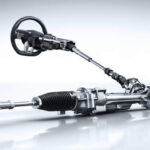
Resolving Fiat 500 Suspension Noises: Tips and Tricks

The Fiat 500 is a stylish and fun-to-drive car, but like any vehicle, it can develop issues over time. One common problem that owners may encounter is suspension noise, which can be annoying and concerning. Fortunately, resolving Fiat 500 suspension noises is often a straightforward process that can be achieved with some basic knowledge and DIY skills. In this article, we'll explore the common causes of suspension noise in the Fiat 500 and provide tips and tricks for diagnosing and fixing the issue, helping you to enjoy a smoother and quieter ride.
Diagnosing and Fixing Common Suspension Issues in Your Fiat 500
The Fiat 500 is known for its stylish design and fun driving experience, but like any vehicle, it can develop issues over time. One common problem that owners may encounter is suspension noise. Suspension noise can be caused by a variety of factors, including worn-out components, misalignment, or improper maintenance. To resolve these issues, it's essential to understand the root cause of the problem and take the necessary steps to address it.
Identifying the Source of Suspension Noise
To fix suspension noise, you first need to identify the source of the problem. This can be done by performing a series of checks on the suspension system. Start by inspecting the shock absorbers and struts for signs of wear or damage. Check the ball joints and control arms for any play or movement. You can also take your Fiat 500 for a test drive to see if the noise is more pronounced when driving over bumps or making sharp turns.
Replacing Worn-Out Suspension Components
Once you've identified the source of the suspension noise, you can begin replacing the worn-out components. This may involve replacing the shock absorbers, struts, or bushings. It's essential to use high-quality replacement parts that meet the manufacturer's specifications. You can consult your owner's manual or speak with a mechanic to determine the best course of action.
Preventing Future Suspension Issues
To prevent future suspension issues, it's crucial to maintain your Fiat 500's suspension system regularly. This includes checking the suspension alignment and making adjustments as needed. You should also inspect the suspension components regularly for signs of wear or damage. By staying on top of maintenance, you can help extend the life of your suspension system and prevent costly repairs down the road.
| Suspension Component | Common Issues | Recommended Action |
|---|---|---|
| Shock Absorbers | Wear, damage, or leaks | Inspect and replace as needed |
| Struts | Wear, damage, or misalignment | Inspect and replace as needed |
| Ball Joints | Wear or damage | Inspect and replace as needed |
| Control Arms | Wear or damage | Inspect and replace as needed |
| Bushings | Wear or damage | Inspect and replace as needed |
How do I get rid of suspension noise?

To get rid of suspension noise, it's essential to identify the source of the problem. Suspension noise can be caused by a variety of factors, including worn-out or damaged components, loose or misaligned parts, or inadequate lubrication.
Inspecting the Suspension System
Inspecting the suspension system is a crucial step in diagnosing and fixing suspension noise. Start by visually examining the suspension components, including the shocks, struts, springs, and control arms, for signs of wear or damage. Check for any leaks, rust, or corrosion that may be contributing to the noise.
- Check the shock absorbers and struts for leaks or damage
- Inspect the springs and control arms for signs of wear or damage
- Look for any loose or misaligned suspension components
Replacing Worn-Out Components
Replacing worn-out or damaged suspension components is often the most effective way to eliminate suspension noise. If the inspection reveals worn-out or damaged parts, replace them with new ones. Make sure to use high-quality replacement parts that are compatible with your vehicle's make and model.
You may be interested in reading Addressing Fiat 500 Power Steering Failures: What to Check
Addressing Fiat 500 Power Steering Failures: What to Check- Replace worn-out shock absorbers or struts with new ones
- Install new springs or control arms if necessary
- Tighten any loose suspension components to the recommended torque specification
Lubricating Suspension Components
Lubricating suspension components can also help to reduce or eliminate suspension noise. Apply lubricant to the suspension components, such as the ball joints and bushings, to reduce friction and wear. Regular lubrication can help to prevent suspension noise from occurring in the first place.
- Apply lubricant to the ball joints and bushings
- Use a silicone-based lubricant to reduce friction and wear
- Regularly inspect and lubricate suspension components to prevent noise
What is the suspension problem with the Fiat 500?
The Fiat 500 is a popular city car known for its stylish design and compact size. However, some owners have reported issues with its suspension system. The suspension problem with the Fiat 500 is related to its MacPherson strut front suspension and trailing arm rear suspension design, which can be prone to wear and tear over time.
Suspension Wear and Tear Issues
The Fiat 500's suspension system is designed to provide a comfortable ride and stable handling. However, as the vehicle ages, the suspension components can wear out, leading to a decrease in ride quality and handling performance. Some common issues include worn-out shock absorbers, strut mounts, and bushings.
- Worn-out shock absorbers can cause the vehicle to bounce or oscillate excessively, leading to a rough ride.
- Strut mounts can become worn or damaged, causing clunking or knocking noises when driving over bumps.
- Bushings can deteriorate, leading to a loss of suspension alignment and uneven tire wear.
Symptoms of Suspension Problems
When the suspension system of the Fiat 500 starts to fail, it can exhibit various symptoms. These can include a rough or bumpy ride, unusual noises when driving over bumps, or a general feeling of instability or looseness in the vehicle's handling.
- A rough or bumpy ride can be caused by worn-out shock absorbers or struts.
- Clunking or knocking noises when driving over bumps can be a sign of worn or damaged strut mounts or other suspension components.
- Uneven tire wear can be a result of worn or misaligned suspension components.
Maintenance and Repair
To prevent or address suspension problems in the Fiat 500, regular maintenance is essential. This includes checking the suspension system for signs of wear or damage, and replacing worn-out components as needed.
- Regularly inspect the shock absorbers and struts for signs of leaks or damage.
- Check the strut mounts and bushings for wear or damage, and replace them if necessary.
- Ensure proper wheel alignment to prevent uneven tire wear and other suspension-related issues.
Why is my Fiat 500 making a ticking noise?

The Fiat 500 is a popular city car known for its stylish design and fuel efficiency. However, like any vehicle, it can sometimes develop issues that cause unusual noises. A ticking noise, in particular, can be concerning for car owners as it may indicate a problem with the engine or other critical components.
Possible Causes of the Ticking Noise
The ticking noise in your Fiat 500 could be due to several reasons, ranging from minor issues that are easy to fix to more serious problems that require immediate attention. One common cause is low oil pressure or level, which can lead to the engine's components not being properly lubricated, resulting in a ticking or tapping sound.
You may be interested in reading Addressing Fiat 500 Power Steering Failures: What to Check
Addressing Fiat 500 Power Steering Failures: What to Check Fiat 500 Door Handle Repairs: DIY Guide
Fiat 500 Door Handle Repairs: DIY Guide- Low oil level or dirty oil
- Faulty or worn-out engine lifters
- Loose or damaged heat shields
Engine-related problems are a significant concern when it comes to the ticking noise. Issues such as a malfunctioning or worn-out valve train, which includes parts like the valves, lifters, and camshaft, can produce a ticking noise. This is often more noticeable when the engine is cold and may become less pronounced as it warms up.
- Valve train wear or damage
- Incorrect valve clearance
- Problems with the timing chain or belt
Other Potential Sources
Apart from engine-related issues, there are other potential sources of a ticking noise in your Fiat 500. For instance, a loose or damaged accessory belt or its tensioner can cause unusual noises. Additionally, issues with other components like the alternator, water pump, or even something as simple as a loose screw or clip, can also be the culprit.
- Accessory belt issues
- Loose or failing engine mounts
- Problems with other engine accessories
What is the common problem with Fiat 500?

The Fiat 500 is a popular city car known for its stylish design and fuel efficiency. However, like any other vehicle, it has its share of common problems. One of the most common issues with the Fiat 500 is related to its electrical and electronic systems.
Electrical System Issues
The Fiat 500's electrical system can be prone to faults, which can cause a range of problems. For example, some owners have reported issues with the car's battery, alternator, and starter motor. These problems can be caused by a variety of factors, including faulty wiring, corroded connections, and worn-out components.
- Faulty wiring can cause short circuits, which can lead to blown fuses and other electrical issues.
- Corroded connections can prevent the electrical system from functioning properly, causing problems with the car's starting and charging systems.
- Worn-out components, such as the battery and alternator, can need to be replaced over time.
Transmission and Clutch Problems
Some Fiat 500 models have been known to experience transmission and clutch problems. For example, some owners have reported issues with the car's dual-clutch transmission, which can cause problems with gear shifting and clutch engagement. These issues can be caused by a variety of factors, including software glitches, worn-out clutch packs, and faulty transmission solenoids.
- Software glitches can cause the transmission to malfunction, leading to problems with gear shifting and clutch engagement.
- Worn-out clutch packs can cause the clutch to slip or fail, leading to problems with acceleration and gear shifting.
- Faulty transmission solenoids can cause the transmission to malfunction, leading to problems with gear shifting and clutch engagement.
Engine and Cooling System Issues
The Fiat 500's engine and cooling system can also be prone to problems. For example, some owners have reported issues with the car's engine oil leaks, coolant leaks, and overheating. These issues can be caused by a variety of factors, including worn-out engine gaskets, faulty radiator hoses, and clogged cooling system passages.
- Worn-out engine gaskets can cause oil leaks, which can lead to engine damage and other problems.
- Faulty radiator hoses can cause coolant leaks, which can lead to overheating and engine damage.
- Clogged cooling system passages can cause the engine to overheat, leading to problems with performance and reliability.
Frequently Asked Questions
What are the common causes of suspension noises in Fiat 500?
The common causes of suspension noises in Fiat 500 include worn-out ball joints, loose or damaged suspension components, and inadequate lubrication. Additionally, issues with the shock absorbers, struts, or coil springs can also lead to unusual noises. It's essential to identify the root cause to apply the correct fix and prevent further damage to the suspension system.
How to diagnose suspension noises in Fiat 500?
To diagnose suspension noises in Fiat 500, start by inspecting the suspension components for signs of wear or damage. Check the ball joints, control arms, and other parts for any play or movement. Take the vehicle for a test drive to replicate the noise and observe its characteristics. Use a mechanic's stethoscope or a long screwdriver to help locate the source of the noise, and consider consulting a professional mechanic if needed.
You may be interested in reading Addressing Fiat 500 Power Steering Failures: What to Check
Addressing Fiat 500 Power Steering Failures: What to Check Fiat 500 Door Handle Repairs: DIY Guide
Fiat 500 Door Handle Repairs: DIY Guide Fixing Water Leaks Inside Your Fiat 500: Common Causes and Solutions
Fixing Water Leaks Inside Your Fiat 500: Common Causes and SolutionsCan I fix Fiat 500 suspension noises on my own?
Some Fiat 500 suspension noises can be fixed on your own, such as tightening loose components or lubricating worn-out parts. However, more complex issues like replacing worn-out ball joints or shock absorbers may require professional assistance. It's crucial to assess your mechanical skills and the complexity of the issue before deciding to DIY or seek the help of a qualified mechanic to ensure a proper and safe repair.
How to prevent suspension noises in Fiat 500?
To prevent suspension noises in Fiat 500, regular maintenance is key. Regularly inspect and lubricate suspension components, check for signs of wear, and replace worn-out parts promptly. Avoid driving on rough roads or potholes whenever possible, and ensure proper wheel alignment to reduce stress on the suspension system. By taking these steps, you can help minimize the risk of suspension noises and prolong the lifespan of your Fiat 500's suspension.

If you want to know other articles similar to Resolving Fiat 500 Suspension Noises: Tips and Tricks you can visit the category Common Problems.
Deja una respuesta







More content of your interest